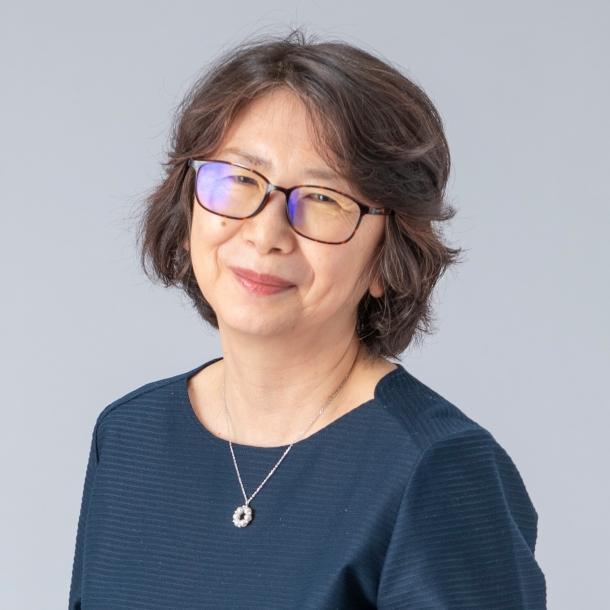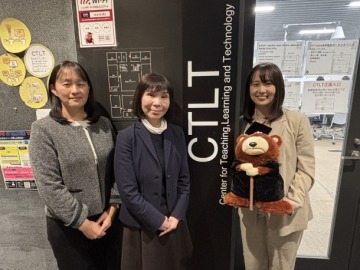Fall Semester 2022 Waseda University Presidential Teaching Award
Subject:Theory of International Politics(E)
SHINOHARA Hatsue
The Theory of International Politics is, by nature, an abstract subject because “theory” intends to simplify and generalize the particularities. Professor Shinohara has worked to teach the subject in an easy-to-understand way and to convey the essence of theoretical traditions by making creative PPT slides. In addition, she used the polling function of Zoom to facilitate active discussions among diverse students.
How can we show the essence of the theory tangibly?
“The Theory of International Politics” is offered at the Graduate School of Asia-Pacific Studies. The student body is diverse. In the Fall of 2022, twenty-four students from sixteen countries took the class. Professor Shinohara had to conduct the course in a hybrid style, where some students were in a classroom while others took the class online via Zoom. The professor tried to facilitate class discussions and to create a cordial atmosphere. When she found a student, whose camera was turned off and was not showing their face, she often called their name to make sure they were listening to and participating in the class.
Professor Shinohara has been teaching at Waseda University for twenty years. Initially, her major was diplomatic history and international history. After she moved to the Graduate School of Asia-Pacific Studies, she started teaching the Theory of International Politics. She did not use PPT slides during the initial period of her teaching, but she started using them in the last seven years, which was quite helpful in teaching the class during the pandemic.
“Theory of International Politics is a well-established standard subject with numerous textbooks. The theory is abstract because it seeks to find some general pattern in international relations. I covered significant theoretical traditions and presented slides signifying each school’s essential theoretical argument with a simplified image based on my understanding,” explained Professor Shinohara.
“When scholars explain the aim of the IR theory, they compare it to ‘lenses’ and ‘maps.’ Following this metaphor, I made approachable slides with illustrations and charts. For instance, when I delivered a lecture on ‘Constructivism,’ I posed a question about how this school comprehends the condition of the world and presented a slide in which two superpowers face each other in a friendly environment filled with ‘heart’ marks. ‘Intersubjectivity’ is a crucial concept of this school, so I added the image of bipolarity in which great powers had eyes and mouths. When I showed this slide, students immediately understood the implications, resulting in their smiles and laughter. Over the years, I have sought to teach the abstract and complicated IR Theory in a tangible, concrete, and accessible manner.”
The instructor shows PPT slides in class. If students want to take a photo of the specific slide, they can do so. When students let the instructor know their absence in advance, she provides them with the slides for the day.
The polling function of Zoom worked well, arousing students’ interest and prompting good discussions.
Professor Shinohara effectively used the polling function of Zoom. Before the class, she prepared some simple questions about the day’s theme. For instance, she asked, “Do you think China and the US will go to war?” The Zoom polling function is easy to use and gives the results instantly. Showing the result of the poll, she asked students why they answered yes or no. Also, she would make a graph of the polling result and upload it to Moodle so that students could review the fundamental theme of the class. One student wrote in the class evaluation: “I think quizzes on Zoom are the most effective way of generating discussion around the main topic.” Professor Shinohara realized just how useful the polling function is during the pandemic. Now, she is back to face-to-face teaching, but as the Zoom polling function was popular and effective, and she wants to continue this method. “I am from Japan, and I offer this class in Japan. However, the students are from various countries. Students’ views and perspectives are different and diverse. Some polling questions show divided opinions, and students can learn that there are different ideas and perspectives. The reasons for their answers are not similar either. Simple polling is a good and easy way to learn different views.”
To facilitate communication and discussions among students: They can learn that views about the world are not synonymous.
Professor Shinohara spent her graduate school years at the University of Chicago. Looking back, one professor inspired her about what a good class should be. “Back then, the professor wrote voluminous information on a blackboard. The professor was a well-known and distinguished fellow in the field. He was over seventy years old, and the class manifested his experience and knowledge. He told me, ‘I know English is not your native language, but the more important thing is how to communicate with the class body.”
The final score of class evaluation was 5.73 out of 6. One student wrote specifically, “Even before I came to campus, I didn’t feel isolated, and instead felt involved.” This student’s remark indicates that the professor’s efforts to facilitate good communication and deepen the students’ understanding were successful. “For instance, concerning the US-China relations, we should not just introduce major views prevalent in the US or the West, as students from other parts of the world may have completely different ideas. When I can successfully pick up diverse views and encourage discussion, the class discussion becomes more fruitful.”
Professor Shinohara wants to design and teach the class based on students’ reviews and evaluations. “I am grateful to students who are devoted and intelligent and sometimes address new questions that opens up new dimensions. Now, I need to return to ordinary face-to-face classroom teaching, but I want to find a way to use the polling function because of its effectiveness and popularity. The conditions of world affairs have been changing and never stayed still. Accordingly, we need to consider theory’s relevance in the changing world. Student diversity is an asset for the class.”






